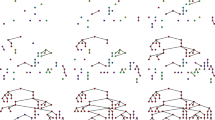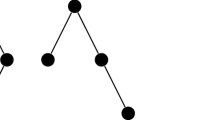Abstract
Let \({{\mathcal {T}}}_{d}(n)\) be the set of d-ary rooted trees with n internal nodes. We give a method to construct a sequence \(( \textbf{t}_{n},n\ge 0)\), where, for any \(n\ge 1\), \( \textbf{t}_{n}\) has the uniform distribution in \({{\mathcal {T}}}_{d}(n)\), and \( \textbf{t}_{n}\) is constructed from \( \textbf{t}_{n-1}\) by the addition of a new node, and a rearrangement of the structure of \( \textbf{t}_{n-1}\). This method is inspired by Rémy’s algorithm which does this job in the binary case, but it is different from it. This provides a method for the random generation of a uniform d-ary tree in \({{\mathcal {T}}}_{d}(n)\) with a cost linear in n.







Similar content being viewed by others
Notes
Again \(i{\textbf {f}}^{(i)}\) is the set by adding i as a prefix to all the nodes of \({\textbf {f}}^{(i)}\), so that in \(\textbf{t}_{n+1}\) the subtree rooted at i is isomorphic to \({\textbf {f}}^{(i)}\).
It could be also natural to assume that this cost in \(O(\log n)\), to take into account the size of the pointers.
An extra cost of \(O(\log n)\) to take into account the bit cost of this random generation is also a natural model.
A cost \(O(\log n)\) is also a natural model.
References
D. Aldous. The continuum random tree. II. An overview. In Stochastic analysis (Durham, 1990), volume 167 of London Math. Soc. Lecture Note Ser., pages 23–70. Cambridge Univ. Press, Cambridge, 1991.
A. Bacher. A new bijection on \(m\)-Dyck paths with application to random sampling. arXiv:1603.06290v2.
J. Bettinelli. Increasing forests and quadrangulations via a bijective approach. JCTA, 122:107–125, 2014.
L. Devroye. Simulating Size-constrained Galton-Watson Trees. SIAM Journal on Computing, 2012, Vol.41, No.1.
S. N. Evans, R. Grübel, and A. Wakolbinger. Doob-Martin boundary of Rémy’s tree growth chain. The Annals of Probability, 45(1):225 – 277, 2017.
B. Haas and R. Stephenson. Scaling limits of \(k\)-ary growing trees. ANN I H Poincare-PR, 51(4):1314–1341, 2015.
P. Marchal. Constructing a sequence of random walks strongly converging to Brownian motion.
J. Neveu. Arbres et processus de galton-watson. ANN I H Poincare-PR, 22(2):199–207, 1986.
R. Otter. The Multiplicative Process. The Annals of Mathematical Statistics, 20(2):206 – 224, 1949.
J.-L. Rémy. Un procédé itératif de dénombrement d’arbres binaires et son application à leur génération aléatoire. RAIRO Inform. Théor., 19(2):179–195, 1985.
Acknowledgements
We thank the anonymous reviewer for her/his comments and suggestions.
Author information
Authors and Affiliations
Corresponding author
Ethics declarations
Conflict of Interest
The author states that there is no conflict of interest.
Additional information
Communicated by Frédérique Bassino.
Publisher's Note
Springer Nature remains neutral with regard to jurisdictional claims in published maps and institutional affiliations.
Rights and permissions
Springer Nature or its licensor (e.g. a society or other partner) holds exclusive rights to this article under a publishing agreement with the author(s) or other rightsholder(s); author self-archiving of the accepted manuscript version of this article is solely governed by the terms of such publishing agreement and applicable law.
About this article
Cite this article
Marckert, JF. Growing Random Uniform d-ary Trees. Ann. Comb. 27, 51–66 (2023). https://doi.org/10.1007/s00026-022-00621-3
Received:
Accepted:
Published:
Issue Date:
DOI: https://doi.org/10.1007/s00026-022-00621-3




